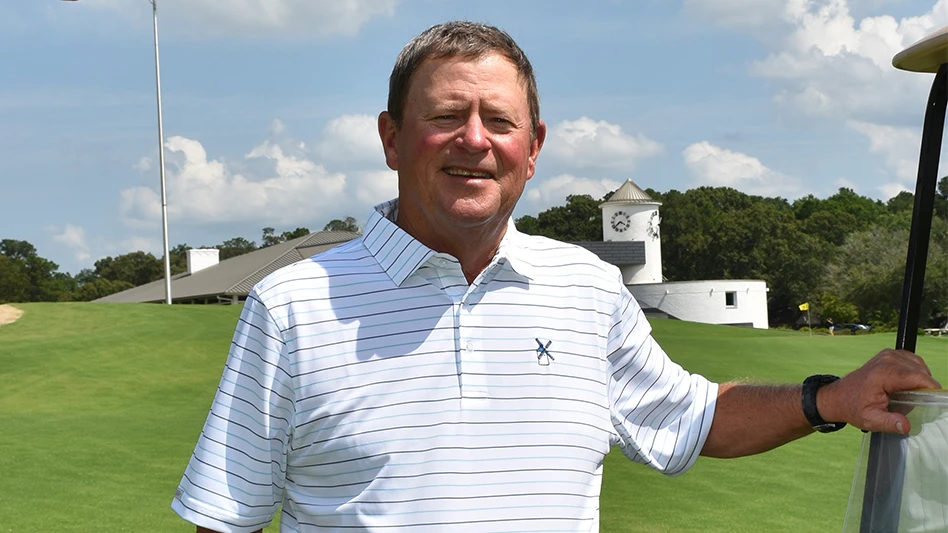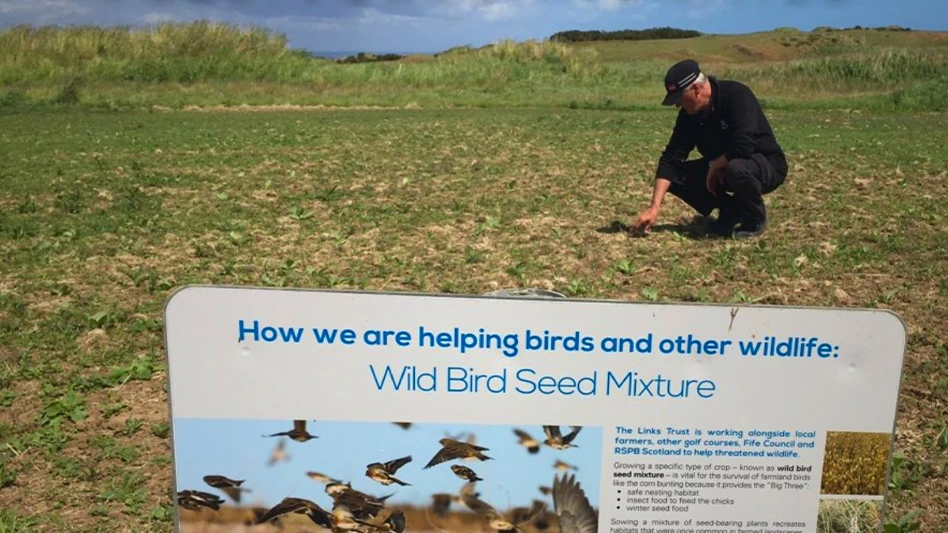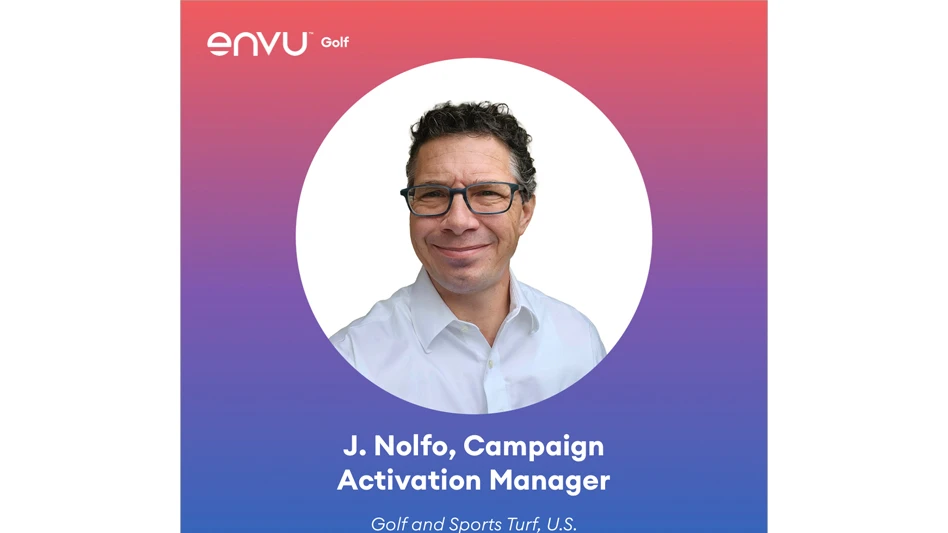 Interviewing Ken Mangum, especially coming off his great success with Atlanta Athletic Club following the 2011 PGA Championship, has been one of the highlights of my journalistic career.
Interviewing Ken Mangum, especially coming off his great success with Atlanta Athletic Club following the 2011 PGA Championship, has been one of the highlights of my journalistic career.
I was fortunate enough to work with Ken on a variety of GCSAA committees in the 1980s and eventually as fellow board members in the 1990s.
Over that time my appreciation for Ken has grown significantly. He is a soft-spoken giant in the industry who is armed with an infectious smile. Ken is a quiet and gentle fellow, but when he speaks everyone listens.
He is as loyal and dependable as they come in the world of golf. He learned from his mentors and mentors the next generation not only in agronomics, but leadership, as well.
I've been fortunate to have known Ken all these years and honored to interview him after his great success at this year's PGA Championship.
I believe I mirror the views of many of my contemporaries when I say that when I think of professionalism in our business, I think of Ken Mangum.
Now with the big event over, I had an opportunity to sit down with Ken to discuss the days leading up to the championship, the lessons learned both on and off the course and how this experience has impacted him as a turf professional.
How many years has it taken to prepare the course for the tournament?
The preparation started with our first rebuild of the greens and bunkers in 1994-95. The greens we played this week were built and contoured then. The highly successful renovation of the Riverside Course forced us to start planning for Highlands in 2005 and do the work in 2006. All the fairways were laid out then because of the inside-outside irrigation layout. Rees Jones, Kerry Haigh and I worked hard to make sure we had the right widths five years out. Nothing was changed, so I guess we did a good job. The final and most important change was in 2009 when we changed to Champion Ultra Dwarf greens.
What was your staffing during the tournament and leading up to it as compared to previous years?
Our staffing levels peaked from 2001-07 to as many as 77 people. Those numbers were reduced to 68 since 2008 as a result of lower revenues and the loss of members. We get by with fewer people because we mow less with the new grasses.
Many superintendents who have hosted majors have told me that a major is 90 percent preparation and about 10 percent execution. Would you agree with that?
I have not thought about it that way. We had the golf course where we wanted it two weeks out. After that, we just looked for little things to do. Dead branches were removed, limbs trimmed for views, weeds pulled and we also stepped up the mowing frequency. There was plenty of irrigation and utility locating to do for signage and scoreboards. I would say more 50/50 because we still had plenty of execution to do during our front nine/back nine routine that we use all week.
No matter how well we prepare there are always a few things that are surprises. So what were yours during this event?
The first surprise is that we watered every night – greens, tees and fairways – to keep the course from becoming unplayable. We could have gone over the top very easily. I did not expect to put down that much water. Kerry Haigh wanted the course to play firm, not hard and fair. The other surprise was just how well the Champion held up and how little we had to do to get the speeds. We single cut greens Monday and Tuesday mornings, Wednesday evening, Thursday and Friday mornings. We did double cut on Saturday and Sunday, but only rolled once on Tuesday night to smooth out spike marks from so much practice-round play. Our biggest challenge was keeping them slowed down. Again, Kerry wanted good speed, but not off the charts because of the loss of hole locations.
How many phones, beepers, radios, etc., do you carry the week of the event?
Too many, but only two radios and a phone. I had to stay on the PGA Rules channel with Kerry to monitor play, rulings and any course issues. Let's just say the first two days... there were many issues with the pace of play. I carried our radio so I could relay information from Kerry to Kasey and Tyler. The iPhone was always there, as well. Fortunately, my younger brother, Randy, spent the week with me to assist with radios and appointments. Randy went back to turf school as a second career and worked with me here from 1990-95. He is in sales now with Howard Fertilizer. He was such a help with monitoring and making calls while I did all the media requests that kept on coming. I am not sure I could have made it through the week without him to drive me to and from work and just keep an eye on me. He was a great sounding board for the press conference and generally encouraged me throughout the week.
I know how close your family is. Hopefully you have had a chance to enjoy a few minutes with them as you smell the roses of such an important event.
We did have a dozen roses for that, but not sure I really got to smell them enough with all the pressure from the predictions for this Championship. Pam came out everyday and spent some time with me, along with my daughter, Miranda, son-in-law, Scott, and their kids, Katie and Evan. My son worked with CBS so I saw him quite a bit. It is always good to have the grand kids around. Katie is 7 months old and I held her a couple of days while doing announcements. Now I get to go back to being "Papa" again.
Will there be any letdown after several years of planning and a week of a tournament in which the whole world of golf is focused on the property you manage?
Yes, there will be some. I experienced that a little in 2001. It is something I talked to my staff about, as well. It is a very high pinnacle to reach so you have nowhere to go but down. I will work on through August for restoration and then take a good bit of time off for traveling and fishing with my good friends in September. Fly fishing is the best way for me to unwind and the company of friends like you, Mike Crawford, Gary Grigg, Cal Roth and Darren Davis make it even better. Where are you, Ed Walsh?
What were your greatest challenges during the event?
The high expectations that were the result of Ron Whitten's article, "The South's Gonna Rise Again." It is a great article. I just had to make sure he was right. Pat O'Brien has been telling me for two years that this event would change golf in the south, as well. I felt a great deal of pressure having the first Major on the new grasses. I knew they would perform, but needed to see them do it. Now, I believe we exceeded the expectations and we have set a new standard.
Now that the event is in the history books, were there any particular lessons learned during or prior to the event and would you have done anything differently?
Dealing with the media has become a very big part of championship golf. It is an option that can be a huge benefit if you are prepared to handle all of the requests that come your way. I am so glad I had the media training offered by GCSAA while I was on the GCSAA board. I have continued to work with Mike Jousan of Clear Communications over the years. This training helped me get through all the interviews and the press conference on the Golf Channel. I have received as many compliments on my interviews as I have on the condition of the course. It was great to have Jeff Bollig, GCSAA's director of communications, on hand to help with media contacts and issues. I also had Robin Applebaum, of CSE, on hand all week to assist with and set up interviews with local media.
Were you ready and waiting for the playoff?
Yes, we had people in position to go back and check Nos. 16, 17, 18 and 10 if needed. It only took a few minutes and three people. We had a great ending with a champion who I predict will continue to win and go on to have a great career.
How much excitement was there from your team during the event and what did you do to motivate them daily?
It didn't take much to get them going, but I think that is one area I excelled in. I started a couple of weeks out with talks about making history. I challenged them to exceed what was written in the article. I started off Thursday by holding up a copy of the "South's Gonna Rise Again." I got a few rebel yells out of that one! The guest that we had each day also played a big part in the motivation. I tried to include as many people as possible in the videos and interviews. Kasey Kauff, Highlands superintendent, and his assistant Tyler Anderson were both very good on camera. Every volunteer — with the exception of a couple of people — had a connection to the club as a former superintendent, assistant, intern or long-time sales and service provider. Newcomers quickly noticed the family atmosphere.
Which golf course superintendents or events did you learn the most from prior to the PGA Championship?
The experience of 2001 was invaluable for routing work and getting around the players. The requirements and chain of commands are very different with each organization. I love the structure of the PGA of America. I have one person to deal with – Kerry Haigh. Since we worked together in 2001, we both knew what to expect. The two of us work on a system of trust and respect. On the flip side, he has one person to work with from the club, as well. We discuss things and make decisions based on how the course is playing and what the forecast is. I know he is ultimately responsible for the outcome of the event, so I try to meet or exceed any request he has for course conditioning – nothing like teamwork. I have always picked up a few gems from friends in the business that have had or been involved in championships. Cal Roth, Collier Miller, Mike Crawford, Mark Kuhns, Jim Nichol, Michael Lee, Steve Cook , Tom Lively, Mark Wilson, Jon Maddern, Mark Woodward, Pat Finlen, Bob Farren, Tim Moraghan, Patrick O'Brien, Chris Hartwiger, Craig Courier, Marsh Benson, Brad Owen, Jim Zimmer, Paul Latshaw Jr. & Sr., Russ Meyers, Matt Schafer, Dave Ward, Gordon Moir, Kenny McKay, Tom Alex and Mark Michaud are some of the people that come to mind. This is quite a list! Now I have to worry who I left off.
What site visits did you make to prepare for this event?
I have been to the Masters every year since 1976. I have attended the PGA since 1995. I don't think I have missed but a couple of US Opens since 1998. You can pick up things every place you go, even though they are all very different venues and grasses.
Tell me a little about your Twitter feeds and blogging for the event.
I find Twitter to be very easy and quick. I would normally tweet on the way in while Randy drove. It is very easy to take a quick picture and send it out with a few words. The blog can be longer and more detailed. It is very quick also. I send the contact information to members so they can follow if they choose to do so. Facebook helps, as well. Kasey and Tyler have set up an AAC Golf Course Management Page. Communication will slow now that the championship is over.
The Champion Bermudagrass greens at AAC have been the buzz of the turf industry. Did they live up to your expectations and do you expect to see a trend for Southeastern courses to switch to improved varieties in the future?
The only reason to change to Champion is if you want great greens to play on all summer.
I could not be happier with the performance during the Championship. It provides us more good months of golf for less money. I don't think the members really care what kind of grass it is as long as it provides a firm, fast surface. As the economy continues to struggle we need to find ways to keep golf sustainable. The money saved on greens alone could be the difference in facilities staying open. More courses will now be advertising "Ultra Dwarf greens" instead of the old ads that used "bentgrass greens" to draw players.
Another key point is that all of the golf course peaks at one time, which gives us more months that we can hold events. The collars also come out of the winter much better because they have been covered and have had much less traffic on them. Many bentgrass courses suffer from "ring around the bent" in the spring. Using the covers allows us to play more golf in the winter since the greens seldom freeze under the cover. We can usually remove the covers in the 9-10 a.m. range for play and the bentgrass greens will still be frozen. Our golfers play more rounds in the winter on the Champion than the bentgrass!
Bruce Williams, CGCS, is the principal in Bruce Williams Golf Consulting and Executive Golf Search. He is an author and speaker in the golf industry, a GCSAA past president and a regular contributor to GCI. Reach him at brucewms1@hotmail.com.

Explore the September 2011 Issue
Check out more from this issue and find your next story to read.
Latest from Golf Course Industry
- Making the grade — at or near grade
- PBI-Gordon receives local business honor
- Florida's Windsor takes environmental step
- GCSAA names Grassroots Ambassador Leadership Award winners
- Turf & Soil Diagnostics promotes Duane Otto to president
- Reel Turf Techs: Ben Herberger
- Brian Costello elected ASGCA president
- The Aquatrols Company story





